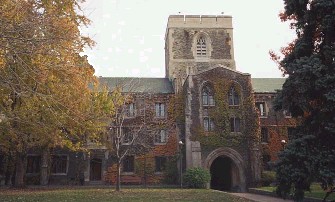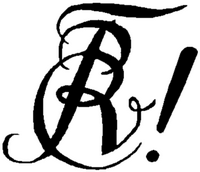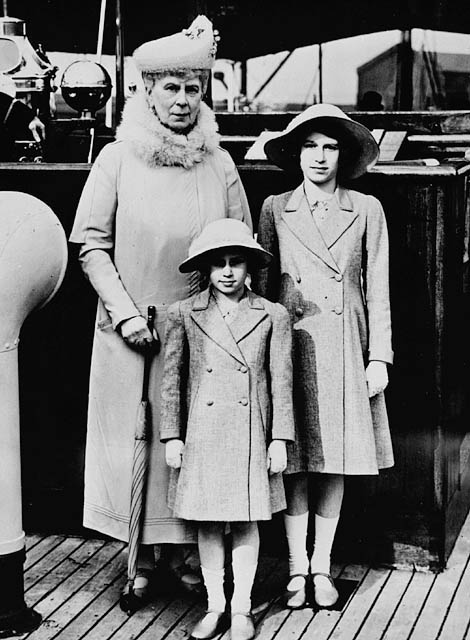|
Royal Victorian Chain
The Royal Victorian Chain is a decoration instituted in 1902 by King Edward VII as a personal award of the monarch (i.e. not an award made on the advice of any Commonwealth realm government). It ranks above the Royal Victorian Order, with which it is often associated but not officially related. Originally reserved for members of the royal family, the chain is a distinct award conferred only upon the highest dignitaries, including foreign monarchs, heads of state, and high-ranking individuals such as the Archbishop of Canterbury. History The Royal Victorian Chain was created by Edward VII in 1902, six years after his mother created the Royal Victorian Order. The Royal Victorian Chain ranks above all decorations of the Royal Victorian Order, but it is not officially part of the Order. Edward created it to honour his mother "as a personal decoration for Sovereigns, Princes, and other Royal personages, and also for a few eminent British subjects." It was first recorded as a new decorat ... [...More Info...] [...Related Items...] OR: [Wikipedia] [Google] [Baidu] |
Commonwealth Realm
A Commonwealth realm is a sovereign state in the Commonwealth of Nations whose monarch and head of state is shared among the other realms. Each realm functions as an independent state, equal with the other realms and nations of the Commonwealth. King Charles III succeeded his mother, Queen Elizabeth II, as monarch of each Commonwealth realm following her death on 8 September 2022. He simultaneously became Head of the Commonwealth. there are 15 Commonwealth realms: Antigua and Barbuda, Australia, The Bahamas, Belize, Canada, Grenada, Jamaica, New Zealand, Papua New Guinea, Saint Kitts and Nevis, Saint Lucia, Saint Vincent and the Grenadines, Solomon Islands, Tuvalu, and the United Kingdom. All are members of the Commonwealth, an intergovernmental organisation of 56 independent member states, 52 of which were formerly part of the British Empire. All Commonwealth members are independent sovereign states, regardless of whether they are Commonwealth realms. At her accession i ... [...More Info...] [...Related Items...] OR: [Wikipedia] [Google] [Baidu] |
Ireland
Ireland ( ; ga, Éire ; Ulster Scots dialect, Ulster-Scots: ) is an island in the Atlantic Ocean, North Atlantic Ocean, in Northwestern Europe, north-western Europe. It is separated from Great Britain to its east by the North Channel (Great Britain and Ireland), North Channel, the Irish Sea, and St George's Channel. Ireland is the List of islands of the British Isles, second-largest island of the British Isles, the List of European islands by area, third-largest in Europe, and the List of islands by area, twentieth-largest on Earth. Geopolitically, Ireland is divided between the Republic of Ireland (officially Names of the Irish state, named Ireland), which covers five-sixths of the island, and Northern Ireland, which is part of the United Kingdom. As of 2022, the Irish population analysis, population of the entire island is just over 7 million, with 5.1 million living in the Republic of Ireland and 1.9 million in Northern Ireland, ranking it the List of European islan ... [...More Info...] [...Related Items...] OR: [Wikipedia] [Google] [Baidu] |
Vincent Massey
Charles Vincent Massey (February 20, 1887December 30, 1967) was a Canadian lawyer and diplomat who served as Governor General of Canada, the 18th since Confederation. Massey was the first governor general of Canada who was born in Canada after Confederation. Massey was born into an influential Toronto family and was educated in Ontario and England, obtaining a degree in law and befriending future prime minister William Lyon Mackenzie King while studying at the University of Oxford. He was commissioned into the military in 1917 for the remainder of the First World War and, after a brief stint in the Canadian Cabinet, began his diplomatic career, serving in envoys to the United States and United Kingdom. Upon his return to Canada in 1946, Massey headed a royal commission on the arts between 1949 and 1951, which resulted in the Massey Report and subsequently the establishment of the National Library of Canada and the Canada Council of the Arts, among other grant-giving agencies ... [...More Info...] [...Related Items...] OR: [Wikipedia] [Google] [Baidu] |
Nickle Resolution
The Canadian titles debate originated with the presentation to the House of Commons of Canada of the Nickle Resolution in 1917. This resolution marked the earliest attempt to establish a Government of Canada policy requesting the sovereign, in the right of the United Kingdom, not to grant knighthoods, baronetcies and peerages to Canadians, and set the precedent for later policies restricting Canadians from accepting titles from foreign countries. Dissatisfaction with the British honours system led to the gradual creation of a separate system for Canada. The Nickle Resolution The Nickle Resolution was a motion brought forward in 1917 by Conservative MP William Folger Nickle in the House of Commons of Canada. There had been controversy before the end of World War I over the honouring of Canadians—especially the appointment of Sam Hughes as a Knight Commander of the Order of the Bath (a non-hereditary honour) in 1915 and the elevation of Hugh Graham as the Baron Atholstan (a her ... [...More Info...] [...Related Items...] OR: [Wikipedia] [Google] [Baidu] |
Title
A title is one or more words used before or after a person's name, in certain contexts. It may signify either generation, an official position, or a professional or academic qualification. In some languages, titles may be inserted between the first and last name (for example, ''Graf'' in German, Cardinal in Catholic usage (Richard Cardinal Cushing) or clerical titles such as Archbishop). Some titles are hereditary. Types Titles include: * Honorific titles or styles of address, a phrase used to convey respect to the recipient of a communication, or to recognize an attribute such as: ** Imperial, royal and noble ranks ** Academic degree ** Social titles, prevalent among certain sections of society due to historic or other reasons. ** Other accomplishment, as with a title of honor * Title of authority, an identifier that specifies the office or position held by an official Titles in English-speaking areas Common titles * Mr. – Adult man (regardless of marital status) ... [...More Info...] [...Related Items...] OR: [Wikipedia] [Google] [Baidu] |
Canadians
Canadians (french: Canadiens) are people identified with the country of Canada. This connection may be residential, legal, historical or cultural. For most Canadians, many (or all) of these connections exist and are collectively the source of their being ''Canadian''. Canada is a multilingual and multicultural society home to people of groups of many different ethnic, religious, and national origins, with the majority of the population made up of Old World immigrants and their descendants. Following the initial period of French and then the much larger British colonization, different waves (or peaks) of immigration and settlement of non-indigenous peoples took place over the course of nearly two centuries and continue today. Elements of Indigenous, French, British, and more recent immigrant customs, languages, and religions have combined to form the culture of Canada, and thus a Canadian identity. Canada has also been strongly influenced by its linguistic, geographic, and ... [...More Info...] [...Related Items...] OR: [Wikipedia] [Google] [Baidu] |
Orders Of Precedence In The United Kingdom
The order of precedence in the United Kingdom is the sequential hierarchy for Peers of the Realm, officers of state, senior members of the clergy, holders of the various Orders of Chivalry and other persons in the three legal jurisdictions within the United Kingdom: * England and Wales * Scotland * Northern Ireland Separate orders exist for males and females. Determination of precedence The order of precedence is determined by various methods. The Precedence Act (which technically applies only to determine seating in the House of Lords Chamber) and the Acts of Union with Scotland and Ireland generally set precedence for members of the nobility. The statutes of the various Orders of Chivalry set precedence for their members. In other cases, precedence may be decided by the sovereign's order, by a Royal Warrant of Precedence, by letters patent, by Acts of Parliament, or by custom. Source of precedence One may acquire precedence for various reasons. Firstly, one may be an office-h ... [...More Info...] [...Related Items...] OR: [Wikipedia] [Google] [Baidu] |
Postnominal Letters
Post-nominal letters, also called post-nominal initials, post-nominal titles, designatory letters or simply post-nominals, are letters placed after a person's name to indicate that the individual holds a position, academic degree, accreditation, office, military decoration, or honour, or is a member of a religious institute or fraternity. An individual may use several different sets of post-nominal letters, but in some contexts it may be customary to limit the number of sets to one or just a few. The order in which post-nominals are listed after a name is based on rules of precedence and what is appropriate for a given situation. Post-nominal letters are one of the main types of name suffix. In contrast, pre-nominal letters precede the name rather than following it, such as addressing a physician or professor as "Dr. Smith". List Different awards and post-nominal letters are in use in the English-speaking countries. Usage Listing order The order in which post-nominal lett ... [...More Info...] [...Related Items...] OR: [Wikipedia] [Google] [Baidu] |
Title
A title is one or more words used before or after a person's name, in certain contexts. It may signify either generation, an official position, or a professional or academic qualification. In some languages, titles may be inserted between the first and last name (for example, ''Graf'' in German, Cardinal in Catholic usage (Richard Cardinal Cushing) or clerical titles such as Archbishop). Some titles are hereditary. Types Titles include: * Honorific titles or styles of address, a phrase used to convey respect to the recipient of a communication, or to recognize an attribute such as: ** Imperial, royal and noble ranks ** Academic degree ** Social titles, prevalent among certain sections of society due to historic or other reasons. ** Other accomplishment, as with a title of honor * Title of authority, an identifier that specifies the office or position held by an official Titles in English-speaking areas Common titles * Mr. – Adult man (regardless of marital status) ... [...More Info...] [...Related Items...] OR: [Wikipedia] [Google] [Baidu] |
Style (form Of Address)
A style of office or form of address, also called manner of address, is an official or legally recognized form of address for a person or other entity (such as a government or company), and may often be used in conjunction with a personal title. A style, by tradition or law, precedes a reference to a person who holds a post or political office, and is sometimes used to refer to the office itself. An honorific can also be awarded to an individual in a personal capacity. Such styles are particularly associated with monarchies, where they may be used by a wife of an office holder or of a prince of the blood, for the duration of their marriage. They are also almost universally used for presidents in republics and in many countries for members of legislative bodies, higher-ranking judges, and senior constitutional office holders. Leading religious figures also have styles. Examples Academia Traditional forms of address at German-speaking universities: *His/Her Magnificenc ... [...More Info...] [...Related Items...] OR: [Wikipedia] [Google] [Baidu] |
Maltese Cross (symbol)
The Maltese cross is a cross symbol, consisting of four " V" or arrowhead shaped concave quadrilaterals converging at a central vertex at right angles, two tips pointing outward symmetrically. It is a heraldic cross variant which developed from earlier forms of eight-pointed crosses in the 16th century. Although chiefly associated with the Knights Hospitaller (Order of St. John, now the Sovereign Military Order of Malta), and by extension with the island of Malta, it has come to be used by a wide array of entities since the early modern period, notably the Order of Saint Stephen, the city of Amalfi, the Polish Order of the White Eagle (1709), the Prussian order ''Pour le Mérite'' (1740), and the Bavarian Military Merit Order (1866). Unicode defines a character named "Maltese cross" in the Dingbats range at code point U+2720 (✠); however most computer fonts render the code point as a cross pattée. History The Knights Hospitaller during the Crusades used a pla ... [...More Info...] [...Related Items...] OR: [Wikipedia] [Google] [Baidu] |
Princess Margaret, Countess Of Snowdon
Princess Margaret, Countess of Snowdon, (Margaret Rose; 21 August 1930 – 9 February 2002) was the younger daughter of King George VI and Queen Elizabeth The Queen Mother, and the younger sister and only sibling of Queen Elizabeth II. Margaret was born when her parents were the Duke and Duchess of York, and she spent much of her childhood with them and her elder sister. Her life changed at the age of six, when her father ascended the British throne following the abdication of his brother Edward VIII. Margaret's sister became heir presumptive, with Margaret second in line to the throne. Her position in the line of succession diminished over the following decades as Elizabeth's children and grandchildren were born. During the Second World War, the two sisters stayed at Windsor Castle despite suggestions to evacuate them to Canada. During the war years, Margaret was too young to perform official duties and continued her education, being nine years old when the ... [...More Info...] [...Related Items...] OR: [Wikipedia] [Google] [Baidu] |




